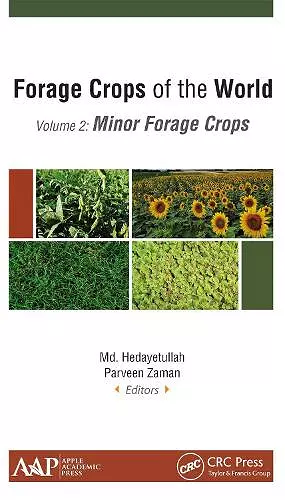Forage Crops of the World, Volume II: Minor Forage Crops
Md Hedayetullah editor Parveen Zaman editor
Format:Paperback
Publisher:Apple Academic Press Inc.
Published:31st Mar '21
Currently unavailable, and unfortunately no date known when it will be back
This paperback is available in another edition too:
- Hardback£116.00(9781771886857)

This book, the second of two volumes, discusses the importance of fodder production of the minor fodder crops for animals. It focuses on 25 minor forage crops, including non-leguminous perennial forages, leguminous forages, and non-graminaceous forages. It discusses crop production methodology and agronomic management in a systemic way, providing an abundance of information on each type of forage crop discussed, including preferred soil type, land capability, cropping patterns, climate, and socioeconomic conditions. It goes on to address pests, disease management, agroforestry in fodder and forage crops, preservation, and production and climate change.
This volume provides valuable information needed for effective forage crop production and management. The book, with chapters from highly qualified scientists, will be a rich resource for researchers, academicians, students, and those in the industry. Forage Crops of the World, Volume I: Major Forage Crops focuses on major forage crops.
Key features:
• Discusses 25 different types of minor forage crops, including many types of grasses and other plants
• Provides information on agronomic production practices
• Covers pest and disease management practices for forage crops
“A great source of information for readers interested in forage crops . . . A detailed account of forage crops . . . The books are a great read for people involved with fodder production and for people practicing sustainable agriculture, who can explore dual-purpose cropping allowing them to cultivate food and fodder together. The reader is introduced to very effective cultivation methods including intercropping as well as agronomic management, post harvesting technologies, and storage and packaging of fodder. . . . Useful for researchers and ecologists conducting studies on forage crops, especially focusing on the impact of climaie change on crops.”
—Economic Botany, 2019, review by Anbreen Bashir, Harris-Stowe State Univesity, Missouri, USA
“A good compilation of all the important forage crops. Scattered information on various aspects of forage crops, including varieties, botanical details, cultural practices, pest-disease problems, climate change, etc., has been nicely compiled in one place. The information provided is aptly compiled and put together. The book provides a handy guide to all the stakeholders, including policyplanners, students, teachers, dairy owners, and forage growers.”
—Dr. Ajoy Kumar Roy, FNAAS, MNASc, FRMSI, FISG, Indian Grassland and Fodder Research Institute
ISBN: 9781774631706
Dimensions: unknown
Weight: 560g
356 pages